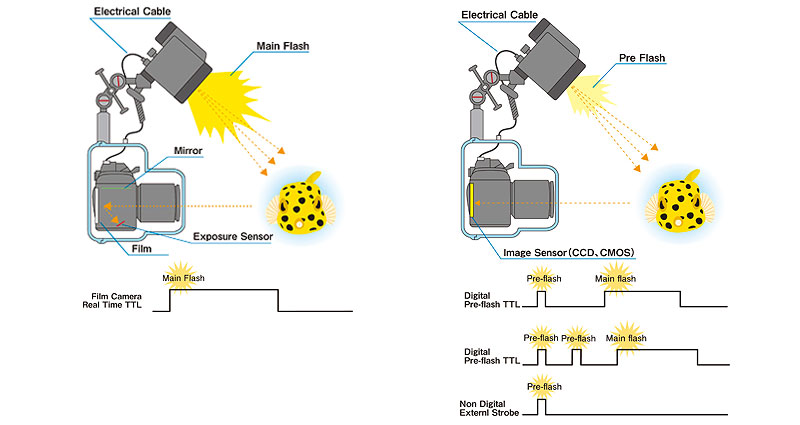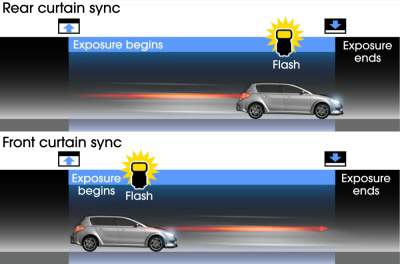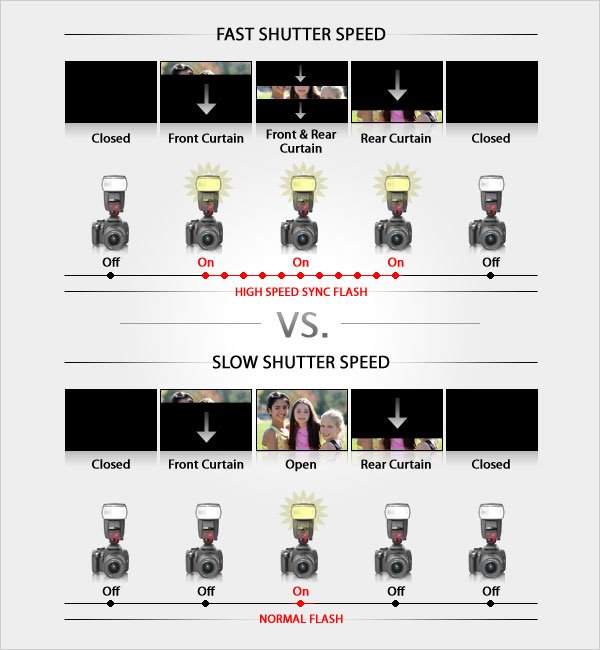
Lenses
Lenses
A lens is a transmissive optical device that focuses or disperses a light beam by means of refraction. A simple lens consists of a single piece of transparent material, while a compound lens consists of several simple lenses (elements), usually arranged along a common axis. Lenses are made from materials such as glass or plastic, and are ground and polished or molded to a desired shape. A lens can focus light to form an image, unlike a prism, which refracts light without focusing.
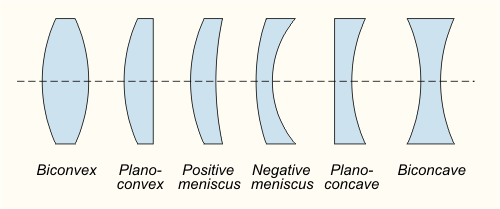
A positive or converging lens in air focuses a collimated beam travelling along the lens axis to a spot (known as the focal point)
at a distance f from the lens. Conversely, a point source of light placed at the focal point is converted into a collimated beam by the lens.
These two cases are examples of image formation in lenses. In the former case, an object at an infinite distance (as represented by
a collimated beam of waves) is focused to an image at the focal point of the lens. In the latter, an object at the focal length distance
from the lens is imaged at infinity. The plane perpendicular to the lens axis situated at a distance f from the lens is called the focal plane.
If the distances from the object to the lens and from the lens to the image are S1 and S2 respectively, for a lens of negligible thickness,
in air, the distances are related by the thin lens formula

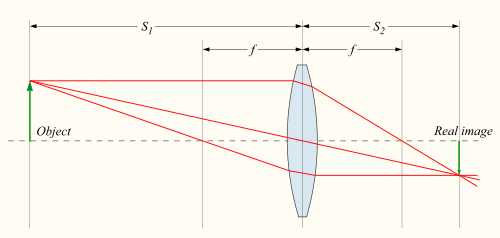
Therefore, if an object is placed at a distance S1 > f from a positive lens of focal length f, we will find an image distance S2 according to this formula. If a screen is placed at a distance S2 on the opposite side of the lens, an image is formed on it. This sort of image, which can be projected onto a screen or image sensor, is known as a real image.
This is the principle of the camera, and of the human eye. The focusing adjustment of a camera adjusts S2, as using an image distance different from that required by this formula produces a defocused (fuzzy) image for an object at a distance of S1 from the camera. Put another way, modifying S2 causes objects at a different S1 to come into perfect focus.
In some cases S2 is negative, indicating that the image is formed on the opposite side of the lens from where those rays are being considered.
Since the diverging light rays emanating from the lens never come into focus, and those rays are not physically present at the point where they
appear to form an image, this is called a virtual image. Unlike real images, a virtual image cannot be projected on a screen, but appears to
an observer looking through the lens as if it were a real object at the location of that virtual image. Likewise, it appears to a subsequent lens
as if it were an object at that location, so that second lens could again focus that light into a real image, S1 then being measured from the
virtual image location behind the first lens to the second lens. This is exactly what the eye does when looking through a magnifying glass.
The magnifying glass creates a (magnified) virtual image behind the magnifying glass, but those rays are then re-imaged by the lens of the eye to
create a real image on the retina.
Magnification
The linear magnification of an imaging system using a single lens is given by:

where M is the magnification factor defined as the ratio of the size of an image compared to the size of the object. The sign convention here dictates that if M is negative, as it is for real images, the image is upside-down with respect to the object. For virtual images M is positive, so the image is upright.
Aperture
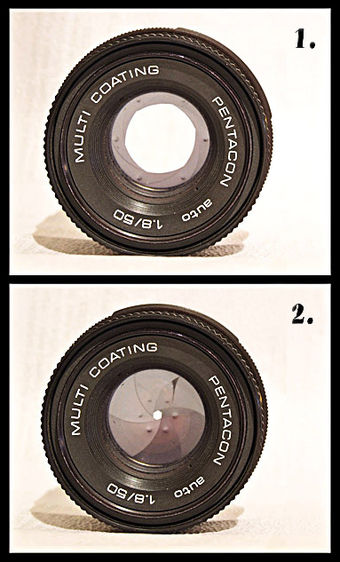 In optics, an aperture is a hole or an opening through which light travels. More specifically, the aperture of an optical system is the opening that determines the cone angle of a bundle of rays that come to a focus in the image plane
In optics, an aperture is a hole or an opening through which light travels. More specifically, the aperture of an optical system is the opening that determines the cone angle of a bundle of rays that come to a focus in the image plane
The aperture stop is an important element in most optical designs. Its most obvious feature is that it limits the amount of light that can reach the image/film plane
the size of the aperture stop is constrained by things other than the amount of light admitted; however:
The size of the stop is one factor that affects depth of field. Smaller stops (larger f numbers) produce a longer depth of field, allowing objects at a wide range of distances to all be in focus at the same time.
The stop limits the effect of optical aberrations. If the stop is too large, the image will be distorted. More sophisticated optical system designs can mitigate the effect of aberrations, allowing a larger stop and therefore greater light collecting ability.
The stop determines whether the image will be vignetted. Larger stops can cause the intensity reaching the film or detector to fall off toward the edges of the picture, especially when for off-axis points a different stop becomes the aperture stop by virtue of cutting off more light than did the stop that was the aperture stop on the optic axis.
A larger aperture stop requires larger diameter optics, which are heavier and more expensive.
In addition to an aperture stop, a photographic lens may have one or more field stops, which limit the system's field of view
The aperture stop of a photographic lens can be adjusted to control the amount of light reaching the film or image sensor. In combination with variation of shutter speed, the aperture size will regulate the film's or image sensor's degree of exposure to light. Typically, a fast shutter speed will require a larger aperture to ensure sufficient light exposure, and a slow shutter speed will require a smaller aperture to avoid excessive exposure.
Reducing the aperture size increases the depth of field, which describes the extent to which subject matter lying closer than or farther from the actual plane of focus appears to be in focus. In general, the smaller the aperture (the larger the number), the greater the distance from the plane of focus the subject matter may be while still appearing in focus.
The lens aperture is usually specified as an f-number, the ratio of focal length to effective aperture diameter. A lens typically has a set of marked "f-stops" that the f-number can be set to. A lower f-number denotes a greater aperture opening which allows more light to reach the film or image sensor. The photography term "one f-stop" refers to a factor of √2 (approx. 1.41) change in f-number, which in turn corresponds to a factor of 2 change in light intensity
Aperture priority is a semi-automatic shooting mode used in cameras. It allows the photographer to choose an aperture setting and allow the camera to decide the shutter speed and sometimes ISO sensitivity for the correct exposure. This is sometimes referred to as Aperture Priority Auto Exposure, A mode, Av mode, or semi-auto mode
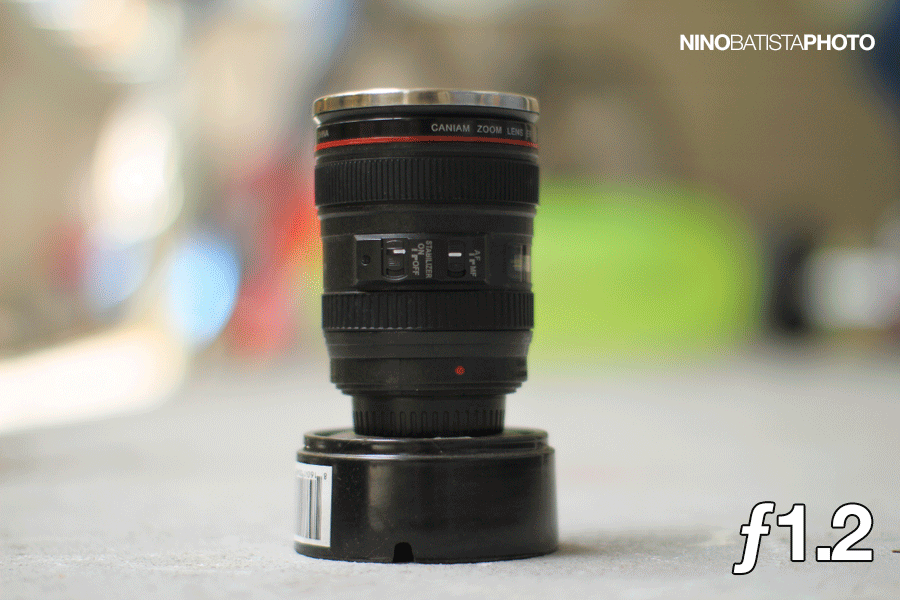
F-number
The F-number is given by
F=f/D
where f is the focal length, and D is the diameter of the entrance pupil (effective aperture
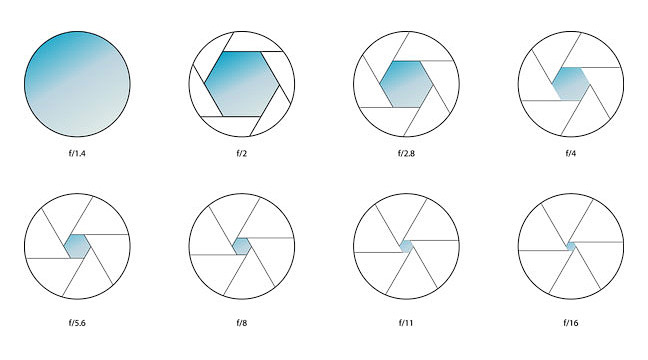
How sensors size affects depth of field
Hyperfocal distance
In optics and photography, hyperfocal distance is a distance beyond which all objects can be brought into an "acceptable" focus. There are two commonly used definitions of hyperfocal distance, leading to values that differ only slightly:
Definition 1: The hyperfocal distance is the closest distance at which a lens can be focused while keeping objects at infinity acceptably sharp. When the lens is focused at this distance, all objects at distances from half of the hyperfocal distance out to infinity will be acceptably sharp.
Definition 2: The hyperfocal distance is the distance beyond which all objects are acceptably sharp, for a lens focused at infinity.
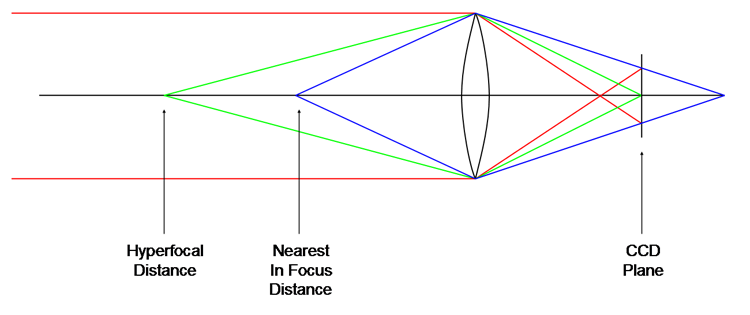
The distinction between the two meanings is rarely made, since they have almost identical values. The value computed according to the first definition exceeds that from the second by just one focal length.
As the hyperfocal distance is the focus distance giving the maximum depth of field, it is the most desirable distance to set the focus of a fixed-focus camera
Manufacturing of lenses
Fresnel lens
Fresnel lenses consist of a series of concentric grooves etched into plastic. Their thin, lightweight construction, availability in small as well as large sizes, and excellent light gathering ability make them useful in a variety of applications. Fresnel lenses are most often used in light gathering applications, such as condenser systems or emitter/detector setups. They can also be used as magnifiers or projection lenses in illumination systems, and image formulation.
A Fresnel lens replaces the curved surface of a conventional optical lens with a series of concentric grooves. These contours act as individual refracting surfaces, bending parallel light rays to a common focal length. As a result, a Fresnel lens, while physically narrow in profile, is capable of focusing light similar to a conventional optical lens but has several advantages over its thicker counterpart.
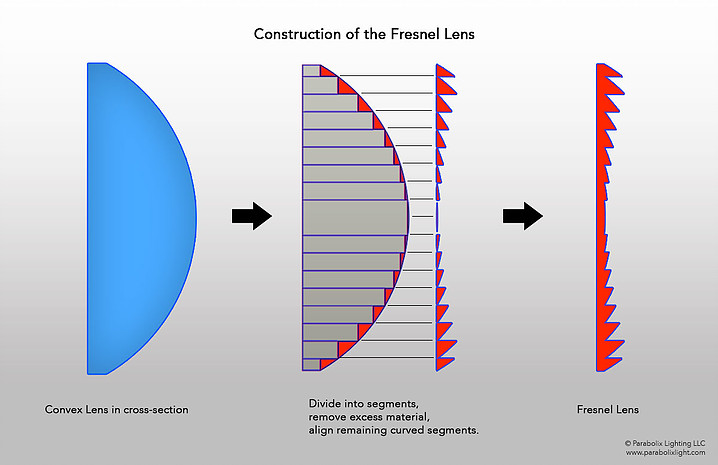
The theory of Fresnel lenses
The driving principle behind the conception of a Fresnel lens is that the direction of propagation of light does not change within a medium (unless scattered). Instead, light rays are only deviated at the surfaces of a medium. As a result, the bulk of the material in the center of a lens serves only to increase the amount of weight and absorption within the system.
To take advantage of this physical property, 18th-century physicists began experimenting with the creation of what is known today as a Fresnel lens. At that time, grooves were cut into a piece of glass in order to create annular rings of a curved profile. This curved profile, when extruded, formed a conventional, curved lens – either spherical or aspherical (Figure 2). Due to this similar optical property compared to a conventional optical lens, a Fresnel lens can offer slightly better focusing performance, depending upon the application. In addition, high groove density allows higher quality images, while low groove density yields better efficiency (as needed in light gathering applications). However, it is important to note that when high precision imaging is required, conventional singlet, doublet, or aspheric optical lenses are still best.
Manufacturing Fresnel lenses
The first Fresnel lenses were made by tediously grinding and polishing glass by hand. Eventually, molten glass was poured into molds, but it was only with the development of optical-quality plastics and injection-molding technology in the 20th-century that the use of Fresnel lenses in many industrial and commercial applications became practical.
Fresnel lenses can be manufactured from a variety of substrates. They are manufactured from acrylic to polycarbonate to vinyl, depending on the desired wavelength of operation. Acrylic is the most common substrate due to its high transmittance in the visible and ultraviolet (UV) regions, but polycarbonate is the substrate of choice in harsh environments due to its resistance to impact and high temperature.
Application
While French physicist Augustin-Jean Fresnel (1788 - 1827) was not the first to conceptualize a Fresnel lens, he was able to popularize it by integrating it into lighthouses. Since then, Fresnel lenses have been utilized in a variety of applications, from light collimation and light collection to magnification.
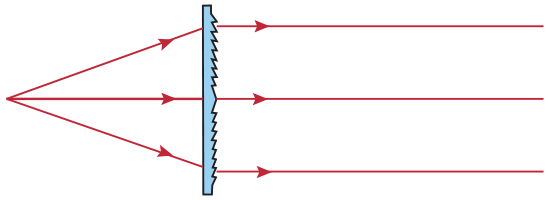
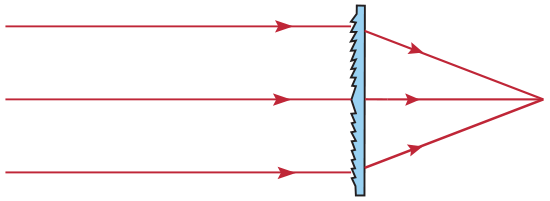
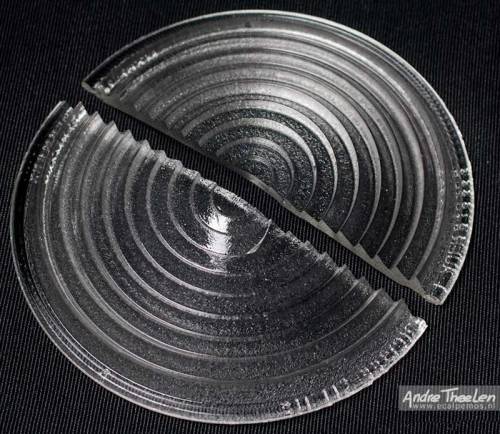
Cylindrical lens
A cylindrical lens is a lens which focuses light into a line instead of a point, as a spherical lens would. The curved face or faces of a cylindrical lens are sections of a cylinder, and focus the image passing through it into a line parallel to the intersection of the surface of the lens and a plane tangent to it. The lens compresses the image in the direction perpendicular to this line, and leaves it unaltered in the direction parallel to it (in the tangent plane).
Cylinder lenses are commonly used as laser line generators, or to adjust image height size or correct for astigmatism in imaging systems or for anamorphic lenses.
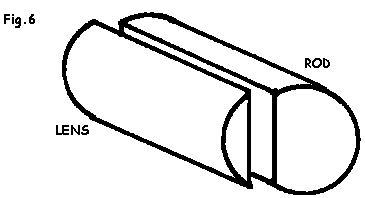
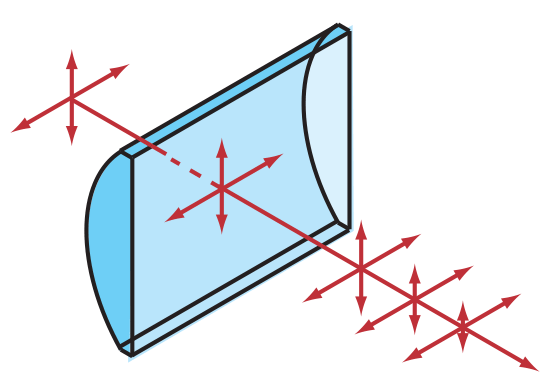
Anamorphic lens
Anamorphic lenses are specialty tools which affect how images get projected onto the camera sensor. They were primarily created so that a wider range of aspect ratios could fit within a standard film frame, but since then, cinematographers have become accustomed to their unique look. This article discusses the key considerations with anamorphic lenses in the digital era.
Overview
Two classes of lenses are typically used in production: spherical and anamorphic. Spherical are more common and are the assumed lens type unless specified otherwise. Spherical lenses project images onto the sensor without affecting their aspect ratio. Anamorphic lenses, on the other hand, project a version of the image that is compressed along the longer dimension (usually by a factor of two). Anamorphic lenses therefore require subsequent stretching, in post-production or at the projector, in order to be properly displayed.
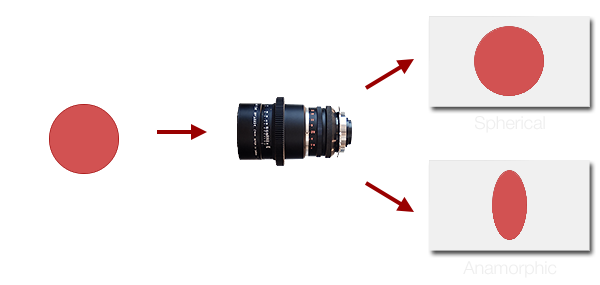
Motivation
Anamorphic lenses were originally designed (1956) so that wide format imagery would fully utilize the film area of standard 35 mm frames. Otherwise wide format imagery would have left the top and bottom of the frame unused, and required cropping these out using masks in the projector:
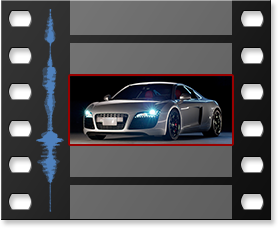

Widescreen without Anamorphic and Anamorphic Widescreen
Anamorphic lenses therefore improved image quality by both enhancing vertical resolution and reducing the appearance of grain. For example, using a standard spherical lens to capture 2.40:1 imagery on 35 mm film only utilizes 50% of each frame’s area. With anamorphic, 100% of the frame area contributes to the final image.
The main reason to use anamorphic with digital is for its other effects. Lens flare and out of focus backgrounds (“bokeh”) will appear elongated as opposed to circular (unless the lens has a specially-designed ovular iris). Flare may also appear as bluish horizontal or vertical streaks which span the entire frame. Vignetting may appear as an oval, although this unique shape can be emulated in post-production.
Depth of field is also affected. Although anamorphic and spherical lenses technically have the same depth of field, in practice you have to use a longer focal length with anamorphic in order to achieve the same angle of view. Therefore, at the same subject magnification, anamorphic lenses produce a shallower, more cinematic depth of field. With film, this difference could be as pronounced as going from a 2X to a 1X crop factor, depending on whether area was reserved for audio.
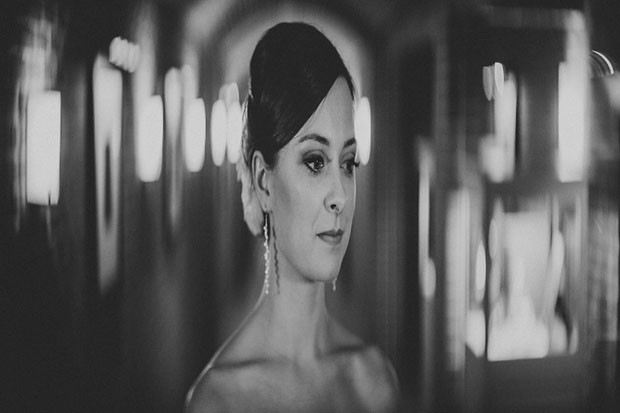
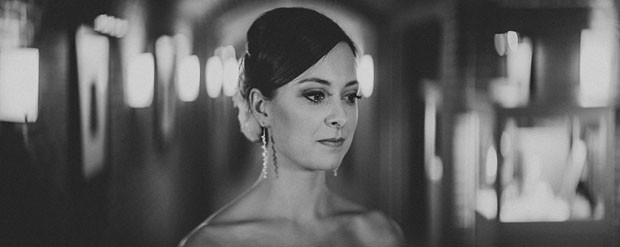
Shutter

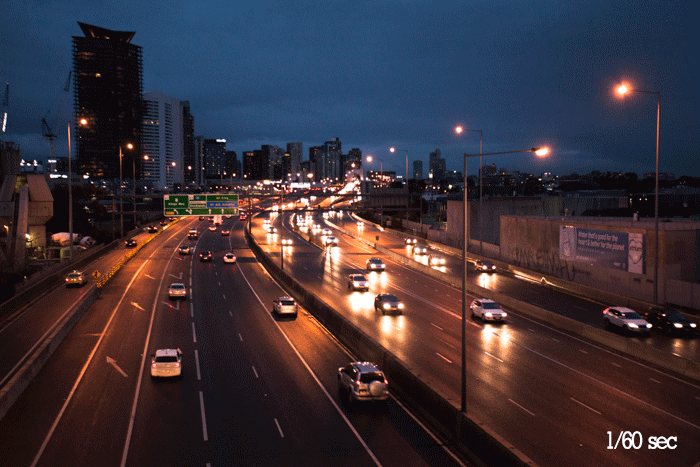
Exposure
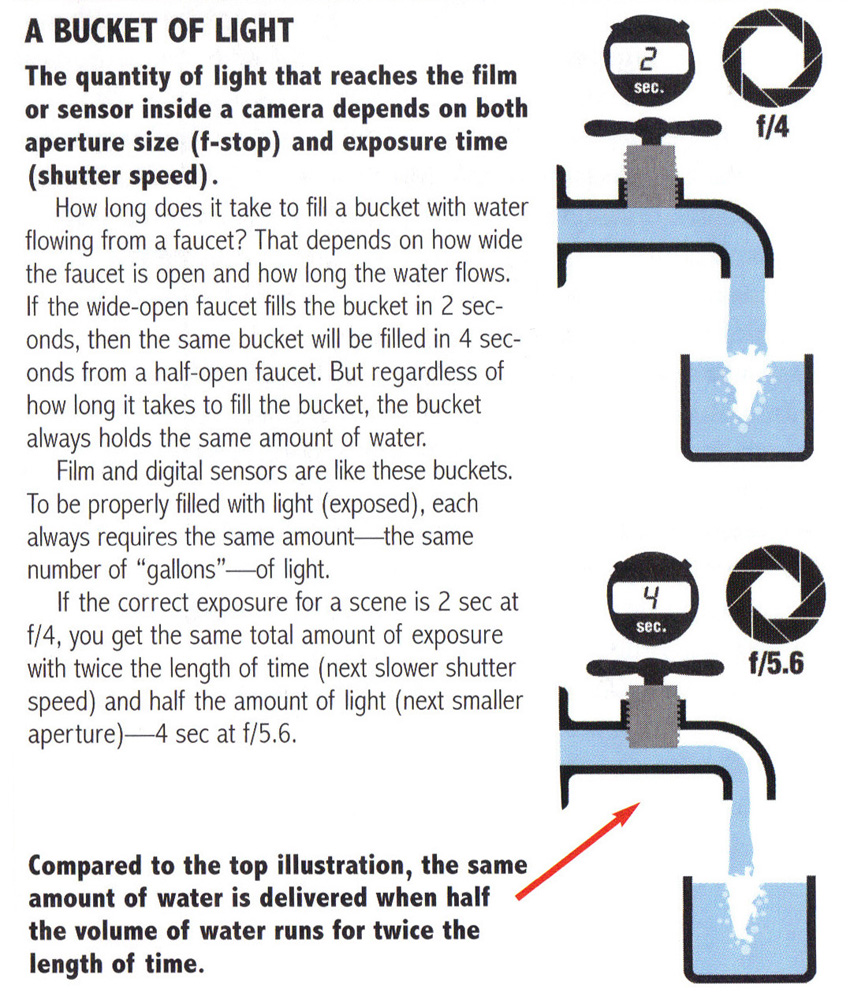
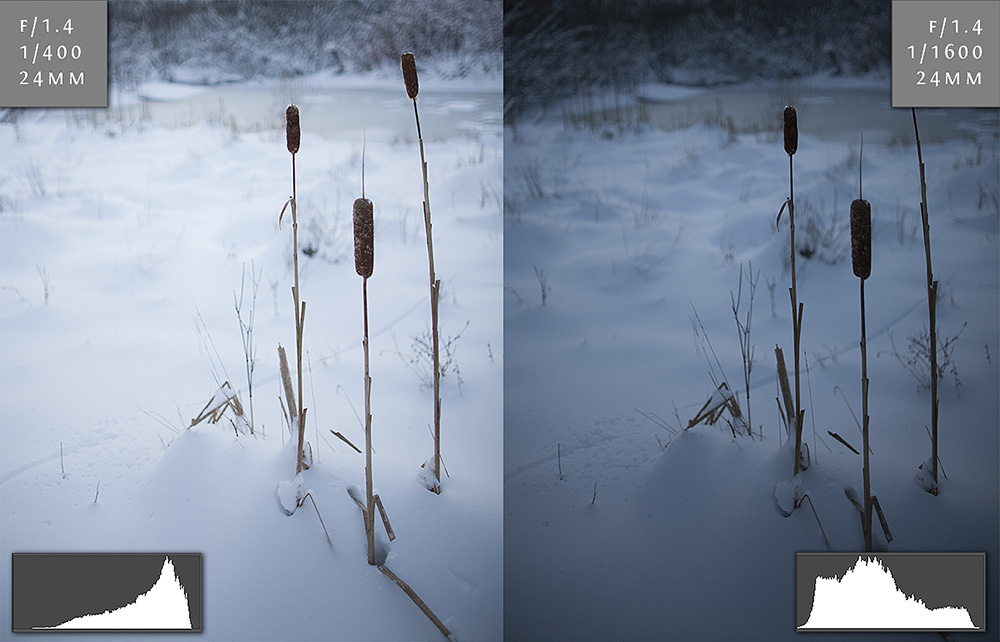

Flash
